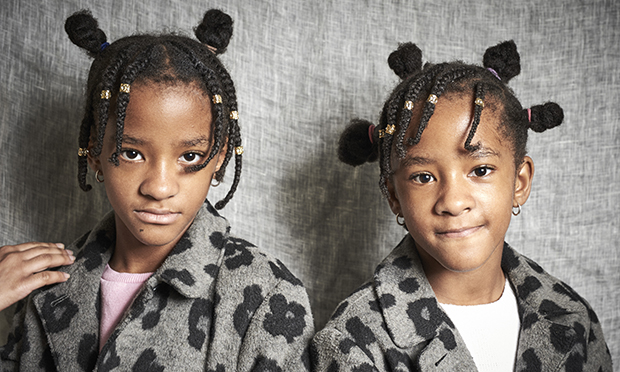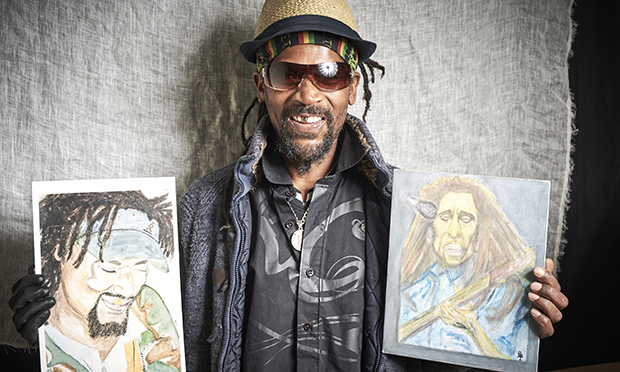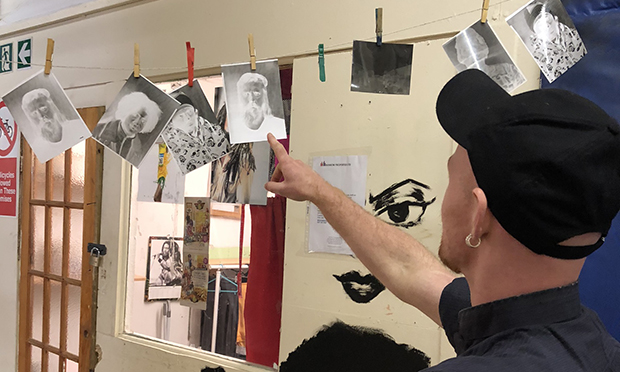Snapshot of Ridley Road: Youth project photographs locals inside under-threat Shopping Village
By Gaia Caramazza | April 17, 2019
Twin sisters Kaylin and Janaia sit for their portrait. Photograph: courtesy of Future Hackney
A small boy poses in front of a 19th century camera that is almost bigger than he is.
He has to stand extremely still whilst the photographers, Brian and Guy, move around him in a flurry.
Outside a makeshift studio inside the Ridley Road Shopping Village, his father and uncle, of Cuban origins, speak in Spanish whilst they observe the youngster trying his best not to flinch.
“My name is Archura,” he says when Brian asks.
After five long minutes, a splash of light fills the small room only for a moment, and Archura is free to go.
Before the next subject is allowed in, the photographer, Brian Whar explains why he decided to use this type of camera: “Ridley Road Market is a bit of an endangered species at the moment, that’s why we bring in methods of photography that are almost extinct – it’s symbolic of this degradation.”
Brian (left) and Guy (right) in the makeshift studio. Photograph: courtesy of Future Hackney
The next subject standing in line is Chrissy, who has come all the way from Wandsworth to meet people from the Afro-Caribbean community that makes up a large part of the market.
Kairi Weekes-Sanderson, born and raised in Hackney, and Andrew Patrick-Walker, who recently moved from Manchester to Dalston, are two of the youth volunteers helping to run the event.
As he ushers Chrissy into the room, Brian adds: “The essence of this project is community – gathering people from different cultures and legacies – bringing it all together.”
This is Future Hackney, a multimedia storytelling collective focused on community engagement and social issues.
The Citizen previously covered its filmmaking project in Dalston, which will be merged with the new portraits to form an exhibition called Ridley Road Stories – the date for which is yet to be confirmed.
The group is documenting changes and gentrification on one of the capital’s oldest and most iconic market streets.
Ridley Road Shopping Village. Photograph: Google.
The location of its temporary studio inside the Shopping Village is somewhat ironic, given the building is currently the subject of a planning application that could lead to the loss of its stalls and artists’ studios.
The proposals have been met with fierce criticism, with the council trying to mediate between the local community and the landlord.
Future Hackney co-founder Donna Travis says she has asked the landlord if Ridley Road Stories can be exhibited inside the building before it all changes, but has not yet had a response.
Donna tells me that young people, from 15 to 28 years old, can attend workshops with Future Hackney to develop their photography skills and much more.
“Our courses are very holistic – its art and community therapy,” she explains. “Hackney has so many people with interesting stories, because it’s so multicultural.
“The young people love it because it’s like history but exciting.”
Local artist Prince, pictured with two of his own paintings. Photograph: courtesy of Future Hackney
The National Lottery-funded initiative is revered for its inclusivity, helping young people not in education or employment, or who have learning disabilities, social anxiety, or just feel shy.
Donna adds that they try to provide a safe space where young people can work on their professional skills to apply for jobs in the industry.
“If you take a young person who feels very shy or inhibited and put them in an office outside of their environment, it’s a bit daunting – I remember feeling like that as a child.
“I think mixing our young people in with people they already know and places they already feel comfortable in is the reason behind all the amazing responses we’ve had.
“We’ve helped a few young people get into university. One of my students, Justine, got into Goldsmiths after leaving school. Even though she was very bright, she just could not get a portfolio together.
“We shot and edited some shots together which helped her get into Goldsmiths.
“Whitney, who started out as a volunteer and then became my assistant, now has a job with an advertising company because she was able to show the work she did on the project.”
Donna shows me around the camp she has set up in the Shopping Village.
“It’s nice to be inside with everyone we know who used to hang out here. It’s a derelict space now but people still seem to be enjoying it.”
In a small stall, they are taking portraits of people coming in from the street, and in a room taped off with black fabric, the team has set up a dark room where they develop the photographs.
As I’m talking to her, a volunteer hangs newly developed photographs on a string across the corridor of the desolate building.
I stop to chat with Kairi, who tells me that Future Hackney is a “once-in-a-lifetime opportunity” for the borough’s youngsters, because it’s free and caters to everyone.
She says: “As a young person, I think the significance of community projects such as this one is that it brings attention to issues such as gentrification.
“Hackney is becoming unrecognisable to the local community that have built it up since they moved here.
“A picture says a thousand words – art narrates different facets of these issues we are facing.”
Andrew Patrick-Walker watches the pictures develop. Photograph: Gaia Caramazza
Andrew Patrick-Walker heard about the project through social media, and wanted to become part of his newfound home in Hackney after moving from a working-class neighbourhood in Manchester.
“I have a kindred spirit with Hackney – it’s a home away from home,” he says. “It is important to be part of where you’re living, rather than setting up camp without understanding the context or the history.
“I’ve been learning loads by talking to the community, and taking photos of my surroundings.”
He says that besides providing a space for creativity, Future Hackney’s workshops are incredibly educational on social issues: “In the workshops we tackle topics that often young people don’t understand. Having a space to do, without the fear of seeming ignorant, is incredibly important.”
“For example, it’s been interesting talking about how this shopping centre is being shut down.
“It’s a shame this project is happening now, when it’s too late. We’re only appreciating it now that it’s going.”
To find out more about Future Hackney, head over to its Instagram feed





